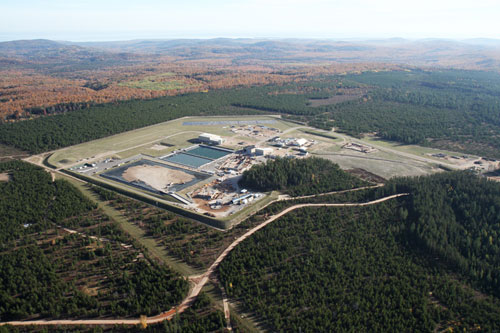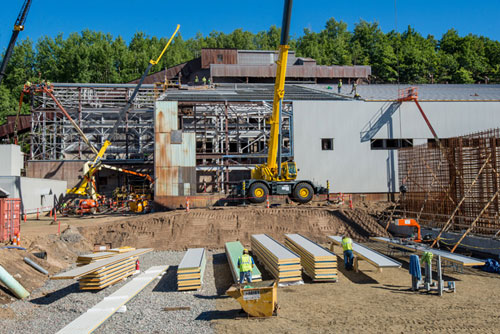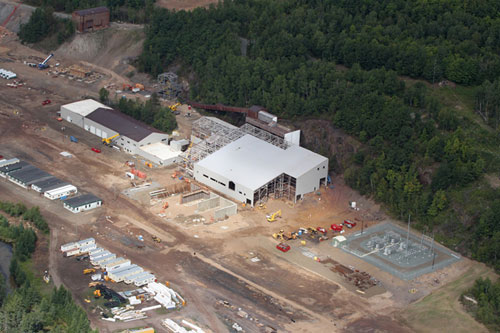U.P.'s latest mining boom brought by the Eagle Project
Date Posted: November 15 2013
MARQUETTE - Progress at the largest ongoing construction projects in the U.P. - the Eagle Mine and Humboldt Mill - "remains on schedule and budget," says the owner of the properties.
That's due in no small part to the work of the building trades, who have been the beneficiaries of a nice employment boom as a result of the mine-related construction. And in the next several months, there's plenty more to come.
Lundin Mining purchased the properties from previous owner Rio Tinto in July for $325 million, and has continued the process of developing Michigan's first new mine in decades. The mine is the only one in North America devoted to nickel extraction. It is expected to produce 360 million pounds of nickel, 295 million pounds of copper and small amounts of other metals over its eight year productive life. Some 330 jobs will be created during the mineral extraction process, which is expected to start in late 2014.
More than 500 Hardhats are being employed during the course of the mine and mill work, now dubbed the combined "Eagle Project," whose operations will be linked when the mineral extraction begins. The Eagle Mine is located in a remote area about 26 miles northwest of Marquette, carved out of about 130 acres of Jack Pine forest.
Already constructed at the mine site are the mine portal, massive water collection basins, a water treatment plant, a water infiltration system, a batch plant, a truck wash, a truck shop, a powerhouse, and mine services buildings. A one-mile decline tunnel will allow access to the minerals below ground, which will be mined using a method known as long-hole stoping. The ore body is roughly six acres in size and reaches depths of over 1,000 feet below the surface.
The ore taken from the mine will be trucked to the Humboldt Mill, about 65 miles from the mine. The mill processed ore and other metals beginning in the 1950s but it has been unused over the last 20 years. It is being renovated by the trades as part of this project. Ore that is mined will be crushed and separated into nickel-copper concentrate at the mill, and the material will then be taken by rail to a smelter and last to a refinery before the metals are ready for use by manufacturers.
While construction at the Eagle Mine has leveled off since 2011 and 2012, it will be picking up over the next several months with the start of some new projects. And it will really be picking up at Humboldt Mill. Tony Retaskie, executive director of the Upper Peninsula Construction Council, said the trades will be especially busy with tasks like installing conveyor systems, ore storage and water treatment processes.
"Right now a large portion of the work is going on at the Humboldt Mill," Retaski said. "But there are still some employment at facilities to be built at the mine, too."
The Humboldt Mill was purchased by worldwide mining firm Rio Tinto in 2008. They obtained the permits necessary to refurbish and operate the mill in 2010. Between 2009 and 2011 the company spent more than $3 million on clean-up and environmental reclamation activities of old mining waste. Construction and equipment upgrades to the mill began in 2012 to prepare the facility for ore production in late 2014.
During the course of this winter and into next year, Iron Workers Local 8 Business Agent Tim Roman said at peak, about 60 iron workers would be employed at the mill, and another 40 will be employed at the mine before it becomes operational.
"These are the man-hours we've been wanting and waiting for, for maybe the last 10 years," Roman said. He said Local 8 has experienced a number of retirements among baby-boomer aged members in the last several years. "This steady employment is great for the trades and a lot of our contractors in the area. A lot of them are getting work they wouldn't normally get, so it's a good time."
The total capital expenditure for the project is estimated at $800 billion.
The Eagle Project represents a major link to the Upper Peninsula's historic mining heritage. According to Lundin, the Humboldt Mill was built and first used by the Cleveland Cliffs Iron Co. for milling of iron ore from their adjacent open pit mine. Cleveland Cliffs ceased operations at the mill in the early 1980s, and sold the property to the Callahan Mining Co. Their operation ended in the early 1990s, and the Humboldt Mill subsequently sat idle and fell into disrepair.
"By utilizing the mill," Lundin said, "we’re able to extract more nickel and copper at lower grades. This leads to a better use of the mineral resource, more jobs, more taxes and a longer mine life."
While the approval of the Eagle Project was controversial because of the concerns of environmentalists, the work has been an economic boon to the building trades and other businesses. Roads have been improved, electric transmission has been upgraded - serving both the mine and the public - and construction jobs have been plentiful.
"This project has supported the U.P. economy for the past several years, and there's more to come," Retaskie said. "Rio Tinto and now Lundin have been great to work with, they have put hundreds of tradespeople to work when the job opportunities have been scarce. It was only a week or so after Lundin took over last summer that they began accelerating hiring. This process has been great for local business, our contractors, our tradespeople - the whole community."

The Eagle Mine is carved out of about 130 acres of forest in the “Yellow Dog Plains” northwest of Marquette. More projects at the site are starting this fall. When the nickel and copper have been extracted from the mine, the area will be returned to its natural state.

ABOUT 65 MILES from the Eagle Mine, the previously abandoned Humboldt Mill is being refurbished to process ore extracted from the mine.

The Humboldt Mill. Photos courtesy Lundin
